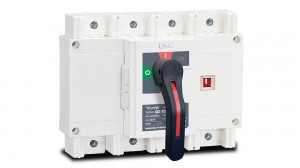1. Structure
1. The isolation switch has a simple structure and consists of a switch mechanism and contacts. Its main function is to cut off or connect the circuit and has good mechanical and electrical characteristics. The fuse-type isolating switch needs to have three parts: a fuse, an isolating switch and a power circuit. The power circuit needs the fuse and the isolating switch to be linked to protect the electrical equipment from abnormal working conditions such as overload, underload or short circuit.
2. The isolating switch usually adopts an indexing structure and has flexible and diverse installation methods. Grounded and ungrounded configurations can be selected according to actual needs. The fuse-type isolating switch is more component-based, and the fuse can be matched according to the rated current of the electrical equipment to ensure the inherent load switching capability of the isolating switch and its ability to withstand high voltage and high short-circuit.
2. Function
1. The main function of the isolating switch is to perform on-off control and play an isolation role during maintenance and repair of electrical equipment. The isolating switch must be used for isolation when operating high-voltage substation equipment. The fuse-type isolating switch also has a fuse protection function, which can protect the access circuit from overheating and overload.
2. Isolating switches are usually used in low-voltage ring networks, which are close to the power supply, and closing the isolating switch only requires a slight load operation; while fuse-type isolating switches are usually used in high-voltage ring networks, and their maintenance operations are complicated and require On the premise of meeting the load switching task, it also has the protection function to the greatest extent, and the requirements for power outage adaptability, insulation level and personal safety are also relatively high.
3. Use
1. Isolating switches are usually used in power isolation, control switches, and cutting off electrical equipment for secondary maintenance operations. Fuse-type isolating switches are usually used in high-voltage equipment such as high-voltage switch cabinets, distribution automation systems, generators, and transformers.
2. In terms of use, the lifting elements of the isolating switch are relatively simple. You only need to meet the standards and select the corresponding specifications; while the fuse-type isolating switch has a higher technical threshold and requires certain technical capabilities to purchase, use, and Maintenance and other operations.
Isolating switches and fuse-type isolating switches are similar in isolation function, but there are great differences in structure, function and use. The selection of a specific isolating switch requires comprehensive consideration of factors such as use occasions, equipment requirements, and production costs.









